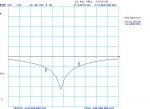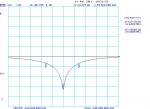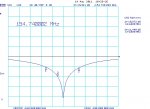I almost decided not to dignify this with a reply, but there are some egregious flaws in your thinking that I can't, in good conscience, allow to be propagated to people who are here to learn.
20dB is so insignificant that the attenuator on a Uniden is, wait, here it comes -- 20dB!
That value was chosen because it IS a significant value, sufficient to eliminate front end overload under most typical circumstances.
You were so desperate to show that you know more that you pulled out an analyzer and started cutting stubs to prove it.
The network analyzer lives on my work bench about 18" from my computer. It gets used almost daily. It's a pretty cool toy, and it's not desperation that causes me to turn it on. Besides, a picture is worth a thousand words, and a real sweep of a real stub made of real coax is pertinent to this discussion.
Maybe even talk about adding a 10dB preamp AFTER the stub to recover some of the loss without the interference.
This statement reflects a profound lack of understanding how receive systems work, and is the main reason I chose to reply at all. I would suggest reading up about noise figure, and how loss and degradation in front of the first active device in a receiver is lost forever and CANNOT be recovered.
I will stick with my statement of +/- 1MHz because the recovery is fast enough.
In spite of the fact that the plots above indicate otherwise? Suit yourself.
Oh, and BTW, the proper term for it is "roll off", not "recovery".
As I pointed out even the PAR spreads out +/-2MHz on both sides until it's only down 6dB.
But my comments relate to coaxial stubs. Why do you keep bringing up PAR filters?
6dB is one S unit and attempting to compare a 100 watt transmitter to a one watt transmitter doesn't fly.
The comparison DOES fly when you're discussing 20db losses.
For a 100 watt transmitter to sound twice as loud you need 800 watts.
Huh? That's a 9db difference. In FM systems, "loudness" of a transmitter is determined by deviation.
But please lose the attitude directed at me.
I only pointed out that while your original post about the stub was correct, the response of the stub would be "broad enough to take out most of the entire band".
Attitude? Just be glad I don't post the PM you sent to me the other day, for all the world to see.
You do not need to find anything I post and offer opposition, which is exactly what you've done.
Only the stuff where you're wrong.
Quit freakin' nit-picking.
Indeed... :roll:





